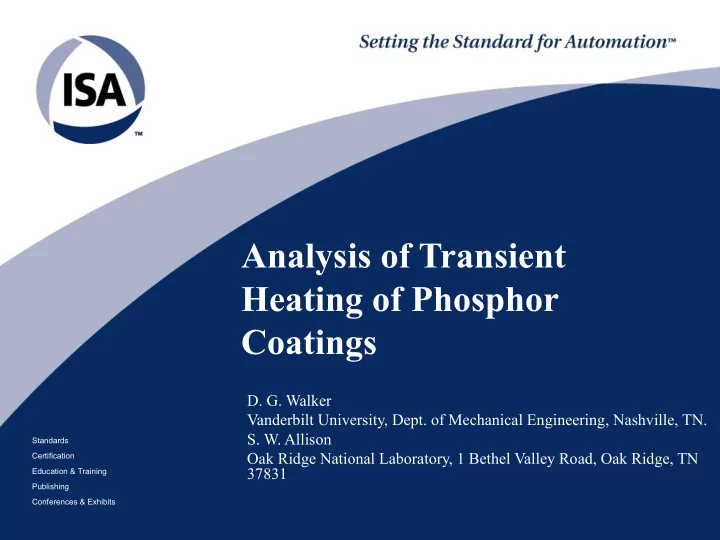

Analysis of Transient Heating of Phosphor Coatings D. G. Walker Vanderbilt University, Dept. of Mechanical Engineering, Nashville, TN. S. W. Allison Standards Oak Ridge National Laboratory, 1 Bethel Valley Road, Oak Ridge, TN Certification 37831 Education & Training Publishing Conferences & Exhibits
Steve Allison • Develops with his close associates thermometry based on phosphor materials. Applications include turbine engines, heat pump efficiency studies, motor-surface measurements, aerodynamic model thermometry, and other applications. He has coauthored about 100 papers and has 9 patents. His current plans concern the development of phosphor thermometry, new optical materials (including nanophosphors and LEDs), and fiber sensor applications. Your company logo – no larger than 2”x3.5” may go here 2
Outline • Justification • Areas of Application • Railgun Example of Transient Heating • Modeling and its Results • Some previous test results evaluated in light of the model • Conclusion 3
Justification • Transient heating situations present a challenging class of problems for temperature diagnostics • Approaches – Thin Film Thermocouples – require connection – Pyrometry – expensive/direct line of sight – Thermographic phosphors – film thickness dependent 4
Areas of Application • Micro and Nano devices • High Pulse Current Devices eg. railguns 5
Railgun Video - Transient Temperature Demonstration 6
Approach • How well does a phosphor layer follow a temperature that rises by 200 C over a period of about 15 ms? • The purpose here is to examine the relationship between the thickness of a phosphor layer and how faithfully in time its temperature matches the temperature of the underlying surface. 7
Modeling – Penetration Depth l =4 α t , Where l is the penetration depth for a semi-infinite slab, the distance into the material to which heat penetrates in time t. ie. ∆ T~99% . (It is analogous to a boundary layer.) Assuming α is equivalent to glass: = − = µ 2 l 4 ( 8 7 m / s )( 15 ms ) 440 m . 8
Modeling continued T(x,t) is conduction solution where φ(t)=ξ*t and ξ is the change in temperature per second If the armature heats up by 200 K in 15 ms , then the heating rate is x»13,000 K / s . The solution of latter equation is shown in the following figure. 9
Temperature solution for a layer of phosphor being heated at x =100µ m . The exposed surface is at x =0 10
50 µm and 20 µm coating results Temperature solution for a layer of phosphor Temperature solution for a layer of phosphor being heated at x =50μ m . The exposed surface being heated at x =20µ m . The exposed surface is is at x =0. at x =0. 11
Temperature of top layer vs thickness of layer. 12
Table of Results Thickness Top layer lag (ms) ΔT top and bottom surface (C) at 200 C 20 1/3 -3 50 2 -25 100 6 -79 13
Nichrome wire coated with phosphor is a good laboratory test bed for producing rapid temperature changes. 14
Periodic Current Applied to Nichrome Square wave current impulse duration = 80 ms 15
temperature profile of nichrome wire current temperature profile of nichrome wire current 300 C temperature swing 1560 cycles/hr 16
17
Conclusions • Nichrome wire test case shows 300 C rise in 80 ms. • Given the difficulty of such measurements, the error associated with a 50 micron coating might be acceptable. • After a sufficient lag time, the temperature rate of change is faithful regardless of coating thickness. • It can be envisioned that the time lag could be an in situ thickness indicator. • Clearly more detailed and rigorous analysis is desirable and the present work is another step toward that goal. 18
References • S. Goedeke, S. W. Allison, M. R. Cates, and P. G. Datskos, “Determination of Surface Temperature on Micrometer Scaled Objects” published in the Proceedings of the 48 th International Instrumentation Symposium of the ISA, San Diego, CA. May, 2002. • L. J. Jaebom and N. A. Kotov, “Thermometer design at the nanoscale” NANO TODAY 2 (1): 48-51 FEB 2007. • D. L. Beshears, Haines, J.R. Earl, D.D. McLawhon, S. LaForge, J.V. Riemer, B.W. Allison, S.W. Cates, M.R.,Tsai, C.C.; “Temperature Rise Measurements for a Simple Mercury Target Exposed to the WNR Proton Beam”, SNS Project Report, SNS101050200-TR007-R00, June 2001. • S. W. Allison, M. R. Cates, S. M. Goedeke, A. Akerman, M. T. Crawford, S. B. Ferraro, J. Stewart, and D. Surls, In-Flight Armature Diagnostics , IEEE Transactions on Magnetics, Vol. 43(1), Jan 2007. (Part II of two parts of Selected Papers from the 13 th International Symposium on Electromagnetic Launch (EML) Technology, Berlin, Germany, May 22-25, 2006.) • D. G. Walker and S. W. Allison, Transient Measurements Using Thermographic Phosphors” ISA Transactions Vol. 46(1), pp. 15-20, Feb 2007. • Fundamentals of Heat and Mass Transfer, F. P. Incropera and D. P. Dewitt, Wiley and Sons, 1994. 19
Recommend
More recommend